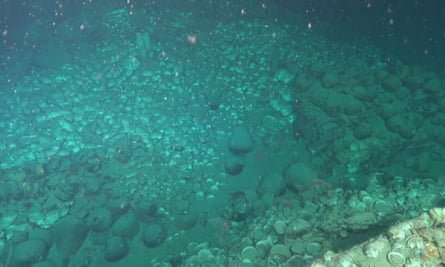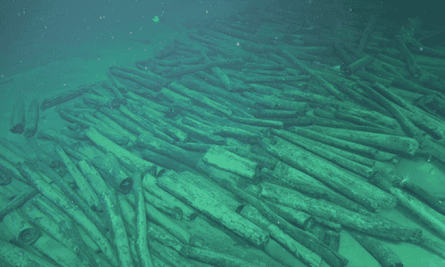
Archaeologists begin excavation of two 500-year-old vessels filled with porcelain and timber
Helen Davidson in Taipei
THE GUARDIAN
Wed 24 May 2023
Two 500-year-old shipwrecks in the South China Sea, filled with Ming-era porcelain and stacked timber, provide significant clues about the maritime Silk Road trade routes, Chinese archaeologists have said.
The two shipwrecks were discovered in October, and cultural and archaeological authorities have now begun a year-long process of deep-sea exploration and excavation, government officials announced.
Marine researchers found the two vessels in the north-west region of the South China Sea, about 1,500 metres below sea level. The officials said the wrecks were “relatively well preserved, with a large number of cultural relics”.
Experts said one of the wrecks dated back to the Ming dynasty’s Hongzhi period, which lasted from 1488 until 1505. It was carrying a cargo of stacked persimmon timber logs and some pottery.
The other wreck dates back to the Zhengde period of 1506 to 1521. The ship was laden with more than 100,000 pieces of porcelain crockery. Photographs show piles of stacked bowls, plates and jars, with intricate designs still visible underneath the sand and mud.

The two shipwrecks were discovered in October, and cultural and archaeological authorities have now begun a year-long process of deep-sea exploration and excavation, government officials announced.
Marine researchers found the two vessels in the north-west region of the South China Sea, about 1,500 metres below sea level. The officials said the wrecks were “relatively well preserved, with a large number of cultural relics”.
Experts said one of the wrecks dated back to the Ming dynasty’s Hongzhi period, which lasted from 1488 until 1505. It was carrying a cargo of stacked persimmon timber logs and some pottery.
The other wreck dates back to the Zhengde period of 1506 to 1521. The ship was laden with more than 100,000 pieces of porcelain crockery. Photographs show piles of stacked bowls, plates and jars, with intricate designs still visible underneath the sand and mud.

One of the vessels was filled with more than 100,000 pieces of Ming-era porcelain crockery. Photograph: State Administration of Cultural Heritage/Government of Hainan province
The archaeologists said the two ancient ships were travelling in different directions, and the wrecks were found less than 20km (12 miles) apart. They said it was the first time vessels returning and arriving had been found near each other, indicating they were travelling on an important trade route.
“It helps us study the maritime Silk Road’s reciprocal flow,” Tang Wei, the director of the Chinese National Centre for Archaeology, said.
The exact location of the wrecks was not disclosed, but the officials said markers were established on the site.
Chinese archaeological exploration has advanced into deeper waters in recent years, after the 2018 establishment of a deep-water archaeology laboratory by the National Centre for Archaeology and the Institute of Deep-Sea Science and Engineering.
The archaeologists said the two ancient ships were travelling in different directions, and the wrecks were found less than 20km (12 miles) apart. They said it was the first time vessels returning and arriving had been found near each other, indicating they were travelling on an important trade route.
“It helps us study the maritime Silk Road’s reciprocal flow,” Tang Wei, the director of the Chinese National Centre for Archaeology, said.
The exact location of the wrecks was not disclosed, but the officials said markers were established on the site.
Chinese archaeological exploration has advanced into deeper waters in recent years, after the 2018 establishment of a deep-water archaeology laboratory by the National Centre for Archaeology and the Institute of Deep-Sea Science and Engineering.

Remains of the shipwrecks were captured during a preliminary search.
Photograph: State Administration of Cultural Heritage/Government of Hainan province
The officials said researchers were taken underwater on Saturday by the submersible Shenhai Yongshi, or Deep Sea Warrior, which can carry people to a depth of 5,000 metres.
There are three phases to the planned research programme, with an estimated 50 dives to be conducted between now and April.
“We first need to figure out the condition of the shipwrecks, and then we can draft plans for archaeological excavation and conservation,” said Song Jianzhong, a researcher at the National Centre for Archaeology.
By mid-June, researchers plan to have assessed the distribution area of both wrecks, put together a widespread data collection and taken archaeological records, extracted some of the relics as specimens, and sampled the surrounding seafloor.
The officials said researchers were taken underwater on Saturday by the submersible Shenhai Yongshi, or Deep Sea Warrior, which can carry people to a depth of 5,000 metres.
There are three phases to the planned research programme, with an estimated 50 dives to be conducted between now and April.
“We first need to figure out the condition of the shipwrecks, and then we can draft plans for archaeological excavation and conservation,” said Song Jianzhong, a researcher at the National Centre for Archaeology.
By mid-June, researchers plan to have assessed the distribution area of both wrecks, put together a widespread data collection and taken archaeological records, extracted some of the relics as specimens, and sampled the surrounding seafloor.
No comments:
Post a Comment